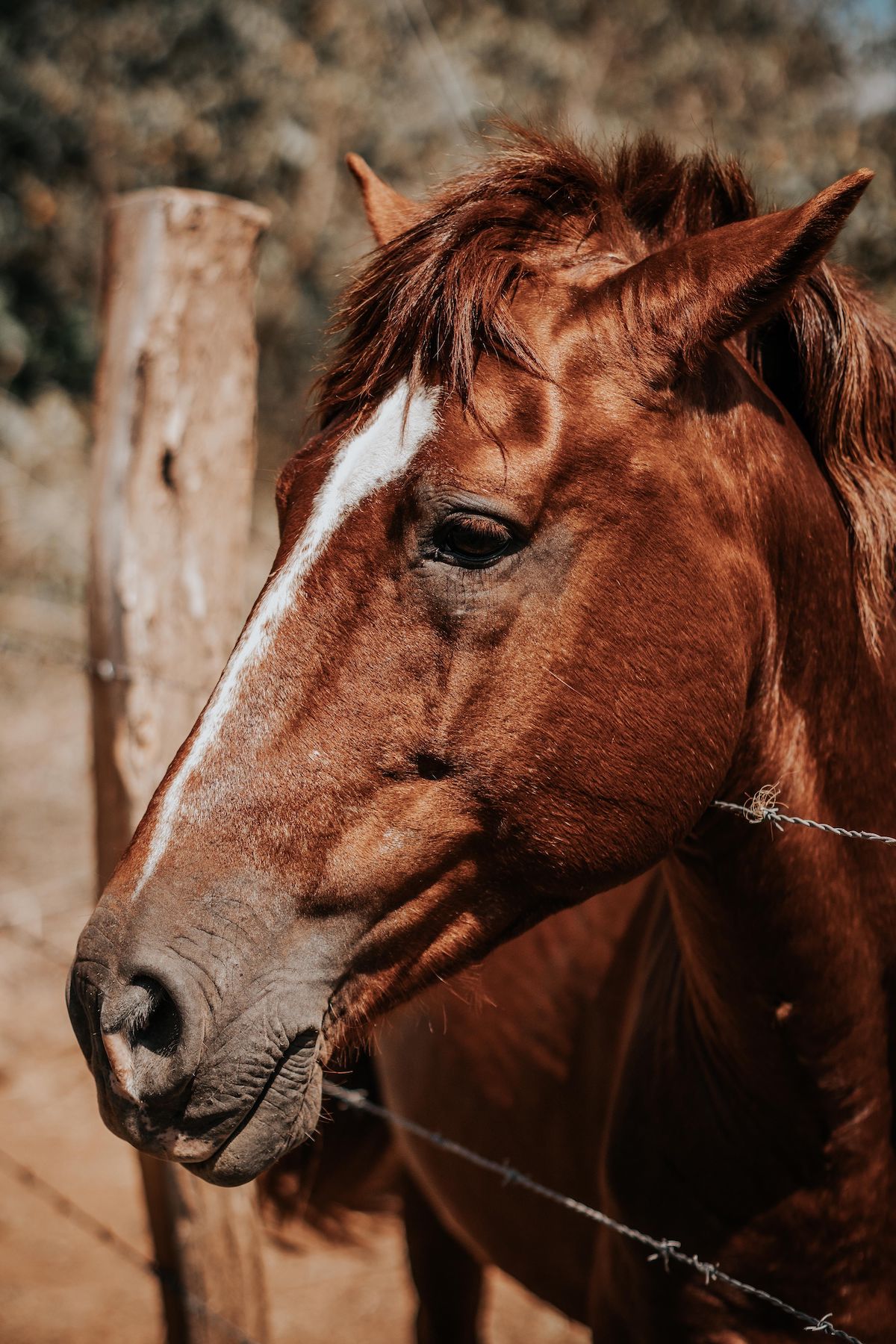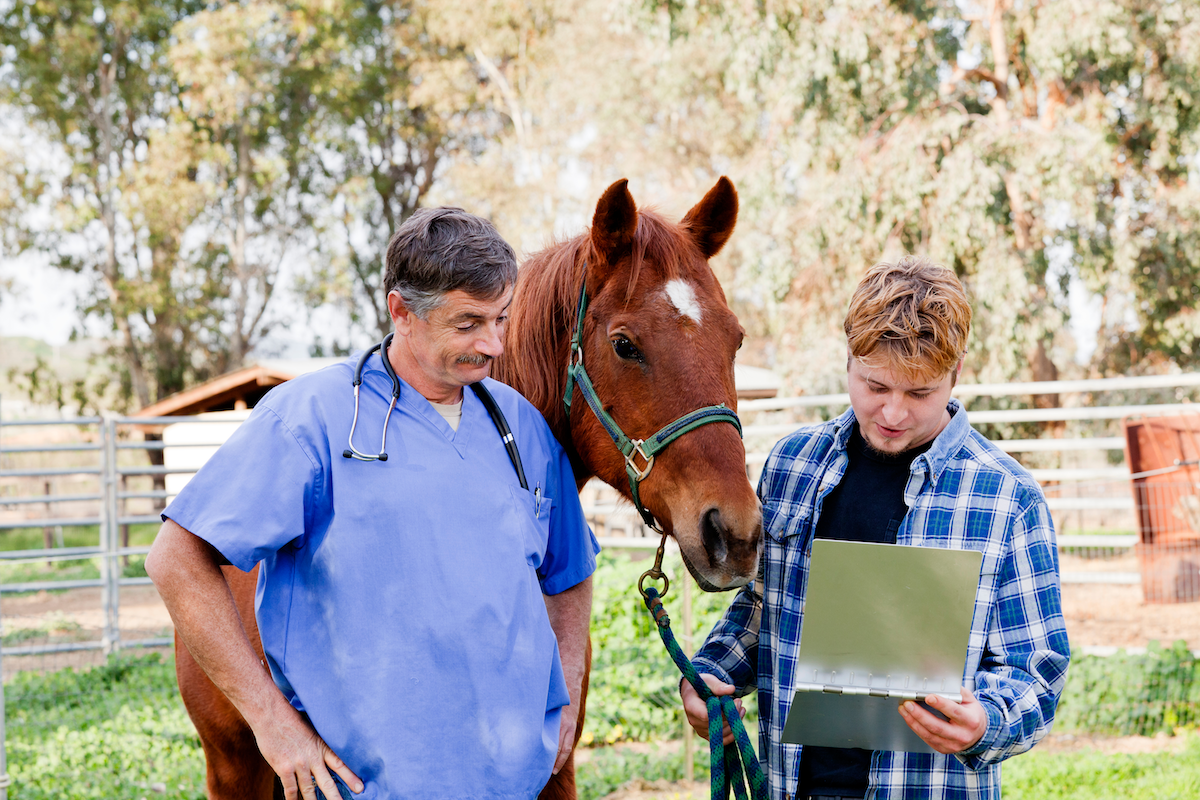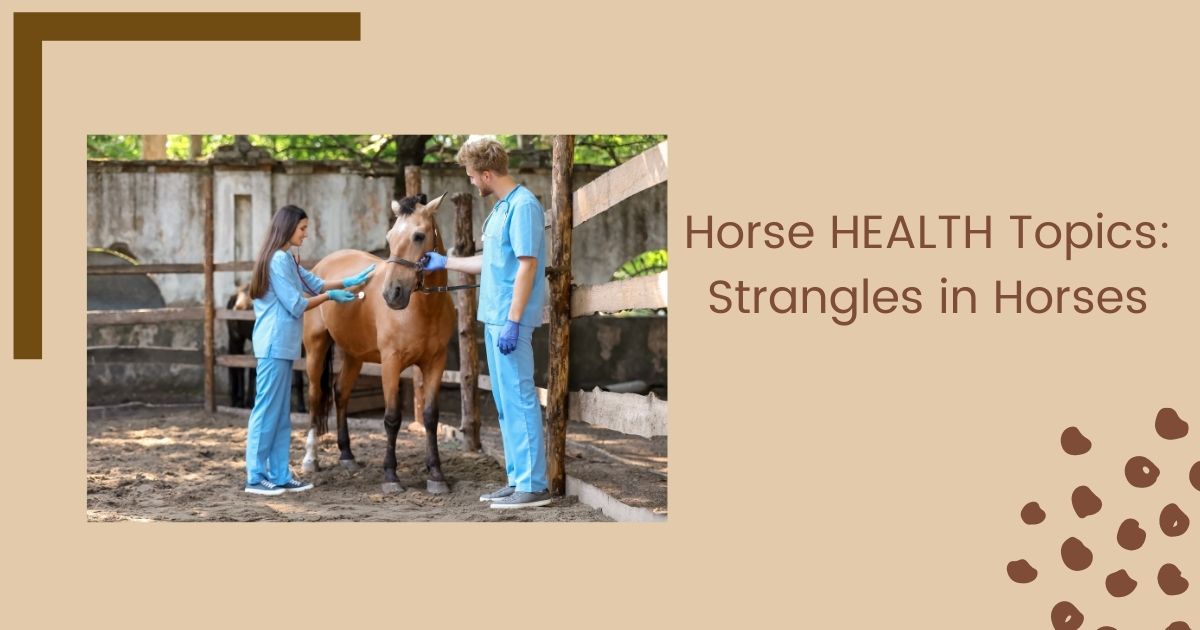What are strangles in horses, and how does it look?
We bet you would be wondering who would be able to hold a horses’ neck and strangle it without being kicked, right? This is far from strangling using that method. Even though horses do choke in a bit, it is not what comes to mind first when we hear this word.
Continue reading to find out more about it.
What is Strangles in Horses?
Strangles is a contagious disease (an infection that can be passed from one animal to another). It is caused by a bacterium Streptococcus equi subspecies equi (S. equi). It is also known as horse distemper. The disease affects the upper respiratory tract – the nose/nostrils, pharynx (throat), and larynx (voice box).
The bacterium infects the lymph nodes around the jaw and neck region by creating abscesses that bust. The infected lymph nodes swell and press on the structures in the upper respiratory system, making breathing difficult. Thus, the horse behaves or looks like it is being strangled.
Strangles affects horses, ponies, and donkeys of all breeds and ages.

Signs and Symptoms of Strangles in Horses
The severity of the disease varies from young to older horses. Young horses show more severe clinical signs, while older horses show less severity in clinical signs. When a horse comes into contact with the bacterium, it takes three to eight days to show clinical signs. This is known as the incubation period.
Fever is the first sign of strangles and occurs two to three days after being infected. Fever is followed several days later by nasal discharges. Nasal discharges start as thin and watery and later become thick and yellow, resembling pus. The discharges are small initially but become voluminous over time.
After a week, the horse gets swollen lymph nodes. Abscesses (collection of pus in an area) form in the swollen lymph nodes. The abscess on the lymph nodes may rupture after a week and drain into the guttural pouch and the skin around the jaw and neck. The guttural pouch is an air-filled sac that forms part of the eustachian tube (a passageway that connects your throat to the middle ear).
Other signs and symptoms include; lethargy (sluggishness), depression, anorexia (loss of appetite), and cough.
The enlargement of the lymph nodes can cause a respiratory obstruction characterized by heavy, labored breathing and difficulty in swallowing, leading to loss of appetite. The horse may hold its head down with its nose thrust forward to alleviate the pain and help respiration. There are also noises made during respiratory inspiration when breathing in.
Even though there is respiratory obstruction, complete obstruction does not occur. Sometimes, an infected horse may develop all the signs and symptoms of strangles without the lymph nodes swelling and producing abscesses. This is known as an atypical or catarrhal form of strangles. Others too develop all the signs and symptoms of the disease.
Is Strangles an Infectious Equine Disease?
An infectious disease is caused by harmful microorganisms such as bacteria, viruses, protozoa, and fungi. They tend to spread from one animal to the other.
Strangles is an equine infectious disease with high morbidity (arising in sickness) but low mortality (death rate) – around 40%, usually from complicated cases. It is highly contagious. Younger horses are more affected, and older horses have an increased risk of infection or re-infection.
The bacteria, Streptococcus equi subspecies equi is highly host-adapted, affecting only horses, ponies, donkeys, mules, and zebras. Its ability to live in the environment depends on the temperature and humidity available. But S. equi is highly subject to extreme heat, dryness/dehydration.
How is Strangles Diagnosed?
Strangles in horses are diagnosed in the laboratory. Samples are taken from nasal swabs, guttural pouches wash, nasal washes, and needle aspirates from abscesses.
These samples are cultured to detect the presence of S. equi. Microbial cultures are relatively not expensive, and they are widely available. The disadvantage of microbial cultures is that detection is restricted when the infection is in the early stages.
Another way of diagnosing strangles is using the Polymerase Chain Reaction (PCR). This method is swift and very sensitive, but it does not differentiate between a dead bacterium and a living one. Thus, with PCR, a positive result doesn’t always mean a present infection.
Imaging such as endoscopy, ultrasound of the retropharyngeal area, and radiography of the skull may be used to determine the location of abscesses in complicated cases.
Blood tests can also be taken from healthy-looking horses to determine whether they are carriers or have been previously exposed to the disease. Horses with a high antibody level in their blood signify a recent infection. However, it can also signify potential carriers.
In cases like these, the only accurate way to differentiate a potential carrier from a recovered horse is to test the guttural wash. An endoscope is used to enter the guttural pouch, and it is flushed with saline, and the fluid that runs back out of the horse’s nose is collected. This fluid is analyzed for dead and living bacteria. Dead bacteria signifying recovered horse and living bacteria signifying carriers.
Known Strangles Treatment for Horses
There is no known fixed treatment for strangles. Usually, it is treated by supportive care and rest. Sometimes, depending on the severity, the horse’s immune system is allowed to recover on its own. If this is done, the horse builds a long-term immunity to strangles.
Ensure that the horse is eating and drinking water during this period. Feed wet and sloppy food on the floor to encourage swallowing and allow the abscesses to drain easily. The environment for housing sick horses should be warm, dry, and free of dust.
Since a bacterial infection cause strangles, it would be appropriate to treat them with antibiotics. The most common types of antibiotics given are penicillin, ampicillin, and ceftiofur. These drugs are given after the onset of fever when a veterinarian has diagnosed the disease. It is advantageous in the prevention of abscesses and to relieve airway obstruction.
Most people prefer not to give antibiotics when the abscess has already been formed. This is because the abscess forms a dense capsule which prevents the antibiotics from reaching it. Thus, the infection continues to spread and delays healing. Therefore, antibiotics are advised to be given at the onset of the condition before the formation of the abscesses.
Antibiotics should be given correctly and with the correct dose, and at the right time to prevent the bacterium from building resistance. Antibiotics are vital because it shortens the course of the disease and prevents complication. However, the disadvantage of giving antibiotics is that it prevents the horses from building immunity to the disease.
Non-Steroidal Anti-Inflammatory Drugs (NSAIDs), which are pain killers, are given to the horses to manage the pain, reduce fever and improve appetite. For horses with abscesses in their lymph nodes, hot packing or topical ichthammol is placed on the abscess to facilitate maturation and rupture. They may also require that the abscess be flushed with dilute povidone-iodine once they have been opened.
In severe complications, tracheotomy (surgical opening of the trachea/windpipe) is done in severe respiratory distress. For carriers, dried pus (chondroid) is removed from the guttural pouches, and also topical antibiotics like penicillin are also used.
It may take up to several weeks until the infection is completely cleared up.

How Can Strangles be Prevented in Equines?
Prevention of every disease is key to promoting good health. However, shedding of the bacteria that causes strangles occurs even before clinical signs begin. Therefore, the best way to prevent strangles is to minimize exposure to the bacterium.
These include avoiding overcrowding and excessive traveling to prevent picking up the bacterium from another farm/ranch or an infected place. Also making sure your horses are well fed to prevent them from succumbing to diseases easily. Finally, avoid allowing your horses to interact with other horses from different areas. For example, do not allow your horses to share buckets, towels, water, and other equipment with other horses when you go for shows.
Vaccination is recommended on farms/ranches with frequent and high outbreaks of strangles. The vaccine can be given inside the upper lip as a submucosal injection. Some are also given intranasally, with two doses given initially within two to three weeks and a yearly booster. The vaccine should be used in conjunction with good farm/ranch practices.
Quarantine new horses and observe them for two to 14 days, frequently taking their temperatures to check for any diseases before adding them to your herd. Isolation grounds should be about 10m from the rest of the group, stud or string, and all equipment and other managements issues should be kept separately.
Horses can have their blood tested to determine those who are carriers and those who are not before they are brought to the farm/ranch or at the end of the isolation period.
Ensure that your farm/ranch is regularly disinfected. Also, provide foot dips at the entrance to the farm/ranch and every stable to prevent the spread of microorganisms from the farm/ranch to the outside world and from the outside world to the farm/ranch.
Complications Arising From Strangles in Horses
The severity of the disease depends on the horse’s immune system, the dose of the bacteria in the body, and the strain (subtype) of the bacteria causing the infection. Complications arising from strangles are rare (about 10%).
Strangles complications usually present as metastatic strangles/bastard strangles where the abscesses occur in other body lymph nodes like the brain, the mammary gland, and the abdomen instead of the neck region. This is fatal. Affected horses may show signs of colic and would have abscesses draining from different parts of the body aside from the jaw and neck region.
Bastard strangles causes the horse to lose weight, develop other diseases and conditions such as multiorgan damage, peritonitis, and pleuritis. Usually, euthanasia (humane killing) is the recommended action for bastard strangles. Read our article and find out how your horse can weight gain with supplements.
Another complication that arises from strangles infection is ‘Purpura hemorrhagica.’ This occurs when there is an unusual immune reaction to the presence of the bacteria in the blood. The immune response causes bleeding from the capillaries and fluid (edema) accumulation in and around the head and limbs. This can lead to circulatory collapse and death.
Purpura hemorrhagica usually occurs in horses that have recovered from strangles, but this doesn’t spread from one horse to another. It is more common in younger horses.
Some horses may become chronic carriers of strangles. The bacteria are carried in their guttural pouches in the form of dried pus known as chondroid. These carriers occasionally spark outbreaks in farms/ranches.
How Is Equine Strangles Transmitted?
Strangles is transmitted through inhalation or ingestion of the Streptococcus equi subspecies equi bacterium. This is through horse-to-horse contact with an infected horse, contacting a piece of infected equipment or material (fomite), or through drinking contaminated water and from people who come into contact with horses.
The bacteria are shed through the nasal discharges and the pus draining from the abscess of infected horses. The bacteria can survive for long periods in the environment, living on water throughs for at least four weeks.
Are Certain Horses Predisposed to Strangles?
Strangles is a worldwide disease. It is very common in horses from six to ten years old. It affects horses, ponies, mules, and donkeys of all breeds, sex, and ages. Thus, no type of horse is predisposed to strangles. The only predisposition is the severity of the disease, which is more severe in young ones than old ones.

How to Control an Outbreak of Strangles in Horses
Sometimes, no matter how strict you are on protocols, there would be a few leaks and breaks leading to an outbreak.
Some horses, although healthy, serve as carriers for strangles by harboring the bacteria in their guttural pouches and shedding it continually, leading to recurring infections. These carriers usually shed the bacteria during stress conditions such as transportation, foaling, deworming and vaccination, and during farriery processes (trimming their shoes).
To control an outbreak, always ensure these events are not stressful for the animal by ensuring that they are handled with care, fed and watered well, and have enough rest.
In the face of an outbreak, these are what you need to do.
Affected horses should be quarantined, and movement of horses from the ranch be halted until they are tested to be negative. The quarantine center should be at least 10m away from the main ranch. Each break-away section should have its own pieces of equipment and water supply.
Horses should be grouped into three during an outbreak. The sick ones should have a red tag in their location, those who were in contact with the sick horses should have an orange tag in their location even if they appear healthy, and horses who were not in contact at all with the sick ones should have a green tag at their location.
All horses in the various groups should be monitored and have their temperatures checked regularly. The horses in the red tag location should be released only after three consecutive negative nasopharyngeal swabs or a single negative guttural pouch wash both on culture and PCR at an interval of four to seven days. The orange and green groups should have their blood tested to rule out being carriers before being released.
All contaminated equipment should be removed from the farm/ranch and properly cleaned and disinfected. In addition, any organic material from the farm/ranch should be removed and properly disposed of.
Handlers should wash their hands before and after touching a sick horse. Sick horses should be touched only after handling all the healthy horses. Ideally, there should be a handler for sick horses and those for the healthy ones to avoid the spread of the disease. Handlers for sick horses should wear protective clothing.
Flies can transmit the disease mechanically. This occurs when they land on a discharge or an abscess; they pick up the bacteria on their feet. The bacteria are spread when the fly lands on a piece of equipment, water/food, or the nasal region. Therefore, it is essential to control the population of flies during an infection.
The farm/ranch should be closed to other horses entering and leaving to contain the outbreak. Pastures and stables where the sick horses were kept should be rested for four to six weeks before bringing in a new horse. Farriers, trainers, and veterinarians should wear protective clothing or change their clothes before visiting a different equine farm/ranch.
Contact your vet as soon as you suspect a horse is sick to prevent the disease from spreading.
What Are The Outcomes for a Horse With Strangles?
Horses with strangles have a good outcome, as far as no complications arise. Horses who don’t have any complications from strangles make a full recovery which occurs between three to six weeks after being sick.
Older horses and horses which have recovered from previous strangles infection have a milder condition when infected. Their illness is mainly limited to the upper respiratory tract, with little to no formation of abscesses and a speedy recovery.
70-75% of horses develop immunity for Streptococcus equi subspecies equi for up to five years and might not be affected by the disease.
Our Take-Home Message
Strangles is a contagious disease caused by a bacterium. This bacterium can survive in the environment for up to four weeks. The disease presents itself with fever, loss of appetite, swollen lymph nodes, and abscesses around the neck and jaw region. Infected animals have difficulty in breathing and swallowing, making it look like they are being strangled.
In as much as antibiotics are required to clear bacterial diseases, antibiotics are not readily advised for strangles. Strangles can be prevented through good biosecurity methods, and outbreaks are managed with isolation.
Recovered horses build immunity against the disease. As a result, Strangles has a reasonably low mortality rate, and with absolute care, your horse can be its usual self again.
